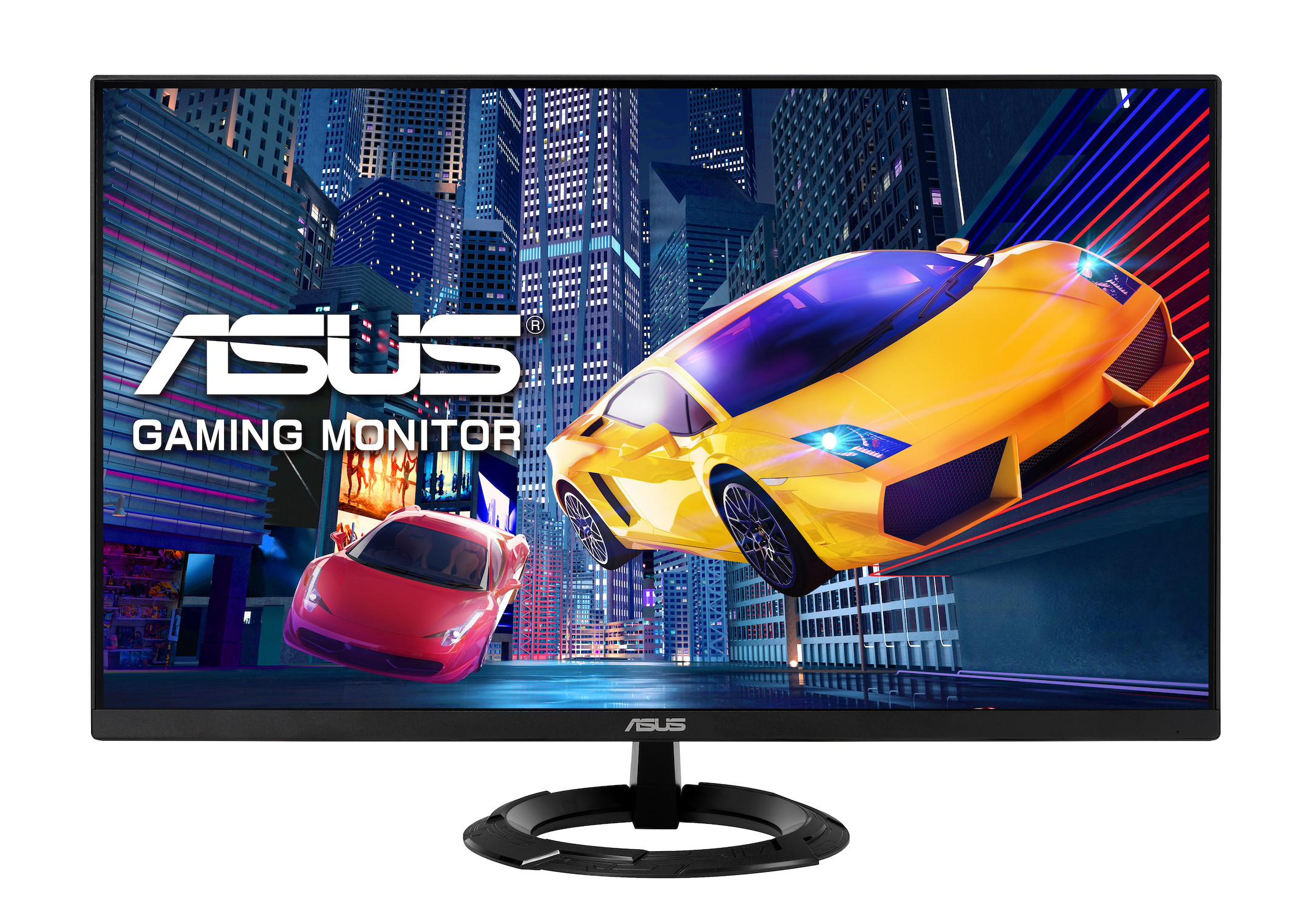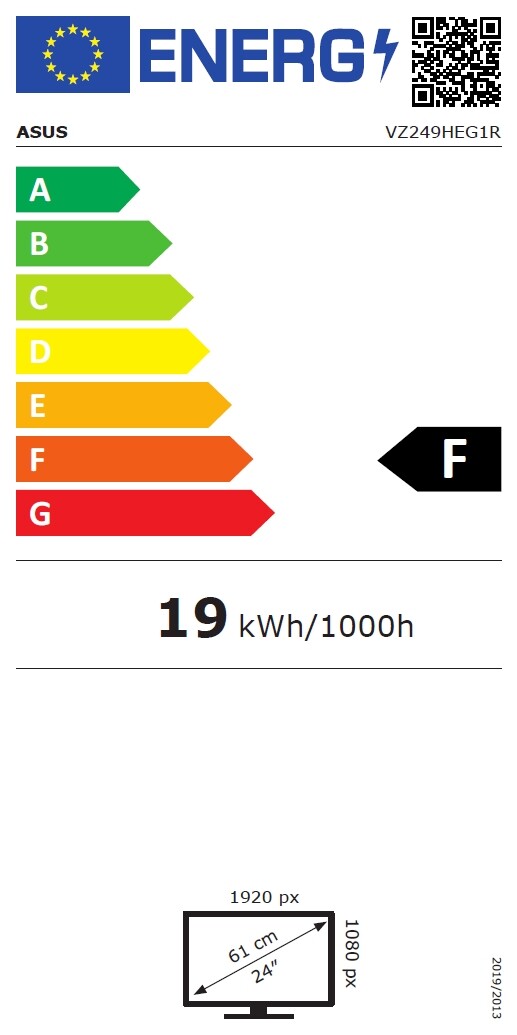























- Resolution 1920 x 1080 Full HD
- Diagonal 24"
- Panel type IPS
- Refresh Rate 75Hz



Product information
ASUS VZ249HEG1R Gaming Monitor - 60.45cm (23.8 inch) Full HD (1920x1080), IPS, 75Hz, 1ms MPRT, Extreme Low Motion Blur™, FreeSync™, ultra-slim design.
60.45cm (23.8 inch) Full HD (1920x1080) IPS gaming monitor with 75Hz refresh rate designed for gamers and immersive gameplay
ASUS Extreme Low Motion Blur (ELMB) technology enables a 1ms response time (MPRT), while Adaptive Sync prevents ghosting and tearing. The result is razor-sharp gaming graphics with high frame rates.
FreeSync™ technology offers variable frame rate for smooth gameplay with low latencies and no tearing allow
Exclusive GamePlus features are designed with the diverse demands of gaming in mind
Certified by TÜV Rheinland for Flicker-Free and Low-Blue-Light technologies, which provide an exceptionally comfortable viewing experience.
The ASUS VZ249HEG1R gaming monitor is built to win in the gaming arena. With its Full HD, IPS panel and 1ms response time, a unique immersion is achieved, allowing you to fully immerse yourself in the gaming world. The screen also has special gaming features, such as ASUS GamePlus technologies, to take your gaming experience to a whole new level.
With its 60.45cm (23.8-inch) Full HD IPS display, the ASUS VZ249HEG1R gives you a brand new Turbo-Rim-based gaming design to match your perfect gaming setup. The ultra-slim profile with a bezel-less design measures just 7.5mm, saving you plenty of desk space.
Lightning fast 1ms response time (MPRT) and 75Hz refresh rate.
Even with the fastest of today's games, the ASUS VZ249HEG1R prevents streaking and motion blur thanks to its 1ms response time (MPRT) and 75Hz refresh rate. This amazing and powerful picture display allows you to react instinctively to what's happening on screen. So you can take corners like a Formula 1 driver or take down an enemy with a well-aimed shot as soon as they let down their guard. In addition, Adaptive-Sync/FreeSync™ prevents tearing, providing a seamless and lag-free image for smooth gameplay.
Multiple connectivity options
Whether you're gaming or streaming video, the ASUS VZ249HEG1R gives you extensive connectivity options, including HDMI(v 1.4) and VGA to support a wide range of multimedia devices.
Special gaming features
Exclusive ASUS GamePlus Technology
Developed in collaboration with professional gamers, ASUS-exclusive GamePlus technology offers special gaming features to help you get more out of your game. With these tools, gamers can practice and improve their gaming skills.
Crosshair
You can choose between six different crosshair options and precisely adjust the position of the crosshair so that you can aim with absolute precision in first-person shooters. This means you always hit your target perfectly, even if the game does not display its own crosshairs or other aiming aids.
Ready for long marathon gaming sessions
Ultra-Low-Blue-Light Technology
ASUS Ultra-Low-Blue-Light technology reduces harmful blue light. The OSD menu allows you to easily select four different filter settings for different scenarios to find the best picture setting depending on your needs.
Low Blue Light Level
The VZ249HEG1R gaming monitor has undergone particularly rigorous performance testing and features technologies to eliminate image flicker and reduce blue light levels, which have been certified by TÜV Rheinland, a global provider of technical, safety and certification services.
Technical data
| Name | Asus VZ249HEG1R 24" IPS Monitor, 1920 x 1080 Full HD, 75Hz, 1ms |
|---|---|
| Article number | 1000013791 |
| GTIN/EAN | 4718017657655 |
| Manufacturer SKU | 90LM05W1-B01E70 |
| EPREL ID | 377972 |
| Model name | VZ249HEG1R |
| Brand | Asus |
| Product Type | Monitor |
| Product Series | Asus VZ Series |
| Technology | LCD |
| Panel type | IPS |
| backlight | LED |
| Resolution | 1920 x 1080 Full HD |
| Diagonal | 24" |
| Aspect Ratio | 16:9 |
| Viewing angle - Horizontal | 178° |
| Viewing angle - Vertical | 178° |
| Contrast Ratio | 1,000 :1 |
| Max. Brightness | 250 cd/m² |
| Response time | 1ms |
| Refresh Rate | 75Hz |
| Support - VESA | 75 x 75 |
| Inputs | 1x HDMI , 1x VGA |
| Features | Flicker Free , Integrated speaker , tiltable |
| Product width | 53.95 cm |
| Product height | 40.65 cm |
| Product depth | 21.3 cm |
| Weight | 3 kg |
| Colour | Black |
| Power consumption (Annual) | 34 kW |
| EEK Spectrum | A to G |
| Energy efficency class | E |
| Delivery contents | Power cable |
| Condition | New |
| Warranty | 24 Month |
| Warranty type | Bringin service Service and support information |
Downloads
Product safety
| Person responsible for the EU |
|---|
| Ninepoint GmbH |
| Im Mediapark 8 |
| 50670 Köln |
| Germany |
| info@asus-shop.de |



